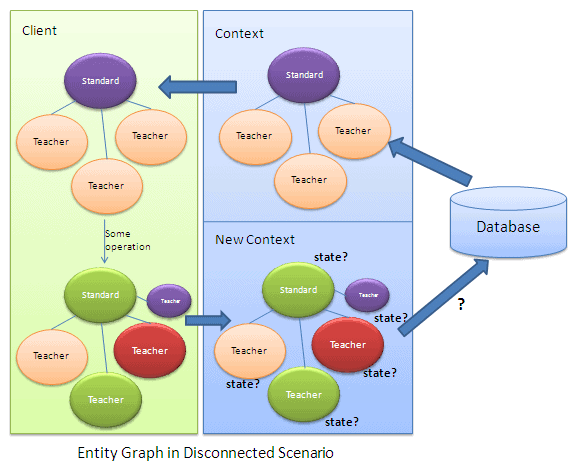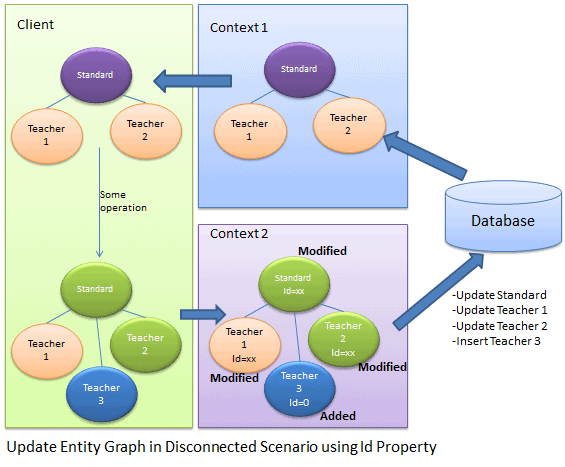Entity Framework Tutorial Basics(27):Update Entity Graph
Update Entity Graph using DbContext:
Updating an entity graph in disconnected scenario is a complex task. It is easy to add a new entity graph in disconnected mode, but to update an entity graph needs careful design consideration.
The problem in updating an entity graph in the disconnected scenario, is that the context doesn't know what operation was performed on it at the client side. As per the following figure, the new context doesn't know the state of each entity:
We need to identify the states of each entity in the entity graph, before calling the SaveChages() method of context. There are different patterns to identify entity state, which we need to consider in designing data layer with Entity Framework.
Patterns of Identifying Entity State in disconnected scenario:
There are several ways (some shown below) to identify an entity state in disconnected scenario:
- Using PrimaryKey (Id) property of an entity
- Having state property in entity set
Note: You can create your own design to identify an entity state based on your architecture. This is just for learning purposes.
1) Using PrimaryKey property of an entity:
You can use the PrimaryKey (Id) property of each entity to determine its entity state. However, you have to decide which of the following architectural rule to use:
- Each type of entity must have Id property (PK)
- Default value of Id property should be 0
As you can see in the figure shown above, the client fetches the Standard and Teacher entity graph and does some operations on it and then sends it to Context 2 to save the changes.
In the disconnected scenario, context2 doesn't know the state of each entity. It has to determine the state of the Standard entity by using StandardId and the state of the Teacher entity by using TeacherId property. If StandardId and TeacherID value is zero, that means it is a new entity and if it is not zero then it is a modified entity.
In the above figure, Standard, Teacher 1, and Teacher 2 have a non-zero Id property value so they are marked as Modified and Teacher 3 Id is zero so it is marked as Added.
The code snippet shown below uses Id property to mark an entity state:
Standard disconnectedStandard = null; using (var context = new SchoolDBEntities())
{
context.Configuration.ProxyCreationEnabled = false; disconnectedStandard = context.Standards.Where(s => s.StandardId == ).Include(s => s.Teachers).FirstOrDefault<Standard>();
}
//Update Standard in disconnected mode
disconnectedStandard.StandardName = "Edited Standard Name"; //Update teachers collection by editing first teacher and adding new teacher
disconnectedStandard.Teachers.ElementAt().TeacherName = "Edited Teacher Name";
disconnectedStandard.Teachers.Add(new Teacher() { TeacherName = "New Teacher", StandardId = disconnectedStandard.StandardId }); using (var newContext = new SchoolDBEntities())
{
//mark standard based on StandardId
newContext.Entry(disconnectedStandard).State = disconnectedStandard.StandardId == ? EntityState.Added : EntityState.Modified; //mark teacher based on StandardId
foreach (Teacher tchr in disconnectedStandard.Teachers)
newContext.Entry(tchr).State = tchr.TeacherId == ? EntityState.Added : EntityState.Modified; newContext.SaveChanges();
}
Advantages:
- No need for extra coding/processing to determine entity state.
- Good performance.
Disadvantages:
- Every entity type needs to have an Id property. It cannot determine states of an entity that do not have Id property.
- Cannot identify an Unchanged entity. It is set to Modified state even if the entity is not changed at all. So, there is an unnecessary database update statement for an unchanged entity.
- Cannot handle delete entity scenario. It needs to handle deletion separately.
2) Having State property in every entity:
Another way to determine entity state is to have a State property in every entity type and set an appropriate state from the client side in disconnected mode. Then we just need to set the entity state as the state property of an entity object before calling SaveChanges of the new context.
Example:
First of all, create an IEntityState interface with enum property called ObjectState:
interface IEntityObjectState
{
EntityObjectState ObjectState { get; set; }
} public enum EntityObjectState
{
Added,
Modified,
Deleted,
Unchanged
}
Now, implement an IEntityObjectState in each entity class, e.g. Standard and Teacher entity, as shown below:
public partial class Standard:IEntityObjectState
{
public Standard()
{
this.Students = new HashSet<Student>();
this.Teachers = new HashSet<Teacher>();
} public int StandardId { get; set; }
public string StandardName { get; set; }
public string Description { get; set; } public virtual ICollection<Student> Students { get; set; }
public virtual ICollection<Teacher> Teachers { get; set; }
[NotMapped]
public EntityObjectState ObjectState
{
get;
set;
}
} public partial class Teacher:IEntityObjectState
{
public Teacher()
{
this.Courses = new HashSet<Course>();
} public int TeacherId { get; set; }
public string TeacherName { get; set; }
public Nullable<int> StandardId { get; set; } public virtual ICollection<Course> Courses { get; set; }
public virtual Standard Standard { get; set; } [NotMapped]
public EntityObjectState ObjectState
{
get;
set;
} }
Set the appropriate state in disconnected mode on client side:
Teacher existingTeacher = null; using (var context = new SchoolDBEntities())
{
context.Configuration.ProxyCreationEnabled = false;
existingTeacher = context.Teachers.FirstOrDefault<Teacher>(); }
Standard disconnectedStandard = new Standard() { StandardName = "New Standard", ObjectState = EntityObjectState.Added };
existingTeacher.ObjectState = EntityObjectState.Modified;
//add existing teacher(in db) to standard
disconnectedStandard.Teachers.Add(existingTeacher);
//add new standard
disconnectedStandard.Teachers.Add(new Teacher() { TeacherName = "New teacher", StandardId = disconnectedStandard.StandardId, ObjectState = EntityObjectState.Added });
Set the entity state as per ObjectState before calling SaveChanges.
using (var newContext = new SchoolDBEntities())
{
//check the ObjectState property and mark appropriate EntityState
if (disconnectedStandard.ObjectState == EntityObjectState.Added)
newContext.Entry(disconnectedStandard).State = System.Data.Entity.EntityState.Added;
else if (disconnectedStandard.ObjectState == EntityObjectState.Modified)
newContext.Entry(disconnectedStandard).State =System.Data.Entity.EntityState.Modified;
else if (disconnectedStandard.ObjectState == EntityObjectState.Deleted)
newContext.Entry(disconnectedStandard).State = System.Data.Entity.EntityState.Deleted;
else
newContext.Entry(disconnectedStandard).State = System.Data.Entity.EntityState.Unchanged; //check the ObjectState property of each teacher and mark appropriate EntityState
foreach (Teacher tchr in disconnectedStandard.Teachers)
{
if (tchr.ObjectState == EntityObjectState.Added)
newContext.Entry(tchr).State = System.Data.Entity.EntityState.Added;
else if (tchr.ObjectState == EntityObjectState.Modified)
newContext.Entry(tchr).State = System.Data.Entity.EntityState.Modified;
else if (tchr.ObjectState == EntityObjectState.Deleted)
newContext.Entry(tchr).State = System.Data.Entity.EntityState.Deleted;
else
newContext.Entry(tchr).State = System.Data.Entity.EntityState.Unchanged;
}
//save changes
newContext.SaveChanges();
}
Advantages:
- No need for extra coding/processing to determine the entity state
- Handles Added, Modified, Deleted, and Unchanged states properly
- No unnecessary update call for unchanged entities.
Disadvantage:
- Need to set the appropriate states of each entity in disconnected mode. So there is a need to be extra careful in disconnected mode.
Entity Framework Tutorial Basics(27):Update Entity Graph的更多相关文章
- Entity Framework Tutorial Basics(4):Setup Entity Framework Environment
Setup Entity Framework Environment: Entity Framework 5.0 API was distributed in two places, in NuGet ...
- Entity Framework Tutorial Basics(42):Colored Entity
Colored Entity in Entity Framework 5.0 You can change the color of an entity in the designer so that ...
- Entity Framework Tutorial Basics(5):Create Entity Data Model
Create Entity Data Model: Here, we are going to create an Entity Data Model (EDM) for SchoolDB datab ...
- Entity Framework Tutorial Basics(26):Add Entity Graph
Add Entity Graph using DbContext: Adding entity graph with all new entities is a simple task. We can ...
- Entity Framework Tutorial Basics(24):Update Single Entity
Update Existing Entity using DBContext in Disconnected Scenario: In this chapter, you will learn how ...
- Entity Framework Tutorial Basics(40):Validate Entity
Validate Entity You can write custom server side validation for any entity. To accomplish this, over ...
- Entity Framework Tutorial Basics(1):Introduction
以下系列文章为Entity Framework Turial Basics系列 http://www.entityframeworktutorial.net/EntityFramework5/enti ...
- Entity Framework Tutorial Basics(32):Enum Support
Enum in Entity Framework: You can now have an Enum in Entity Framework 5.0 onwards. EF 5 should targ ...
- Entity Framework Tutorial Basics(31):Migration from EF 4.X
Migration from Entity Framework 4.1/4.3 to Entity Framework 5.0/6.0 To migrate your existing Entity ...
随机推荐
- (转)msys2使用教程
一.安装 官方下载地址 http://www.msys2.org/ 指定好安装路径(一般D根目录即可),一路下一步就好. 二.配置国内镜像.设置窗体修改颜色 使用[清华大学开源软件镜像站]中的地址,修 ...
- 进程、线程、ThreadLlocal
1.线程是最小的执行单位,而进程中至少一个线程组:如果调度进程和线程,完全由操作系统决定,程序自己不能决定什么时候执行,执行多长时间 Unix/Linux操作系统提供了一个fork()系统调用,它非常 ...
- Agc001_D Arrays and Palindrome
传送门 题目大意 给定一个元素和为$N$的有$M$个数的序列$A$,请你可以$A$元素排列的顺序,并需要构造一个有$K$个($K$可以自己定)数的数列,使得任意一个长度为$N$的字符串,若满足:前$A ...
- HihoCoder1403 后缀数组一·重复旋律1
后缀数组一·重复旋律 时间限制:5000ms 单点时限:1000ms 内存限制:256MB 描述 小Hi平时的一大兴趣爱好就是演奏钢琴.我们知道一个音乐旋律被表示为长度为 N 的数构成的数列. 小Hi ...
- SVN客户端与服务器端搭建
一.客户端安装 1.点击安装程序 2.修改svn安装位置 3.开始安装 4.安装完成 5.回到左面 右键出现svn检出 tortoiSVN 表示安装成功 二.SVN服务端安装 1.点击服务端安装 ...
- karma
一个简单的工具,允许你在多个浏览器中执行JavaScript代码. Karma的主要目的是使您的测试驱动开发变得简单.快速和有趣. 我什么时候该用Karma? 您希望在真正的浏览器中测试代码. 您希望 ...
- 【ASP.NET Web API2】初识Web API
Web Api 是什么? MSDN:ASP.NET Web API 是一种框架,用于轻松构建可以访问多种客户端(包括浏览器和移动设备)的 HTTP 服务 百度百科:Web API是网络应用程序接口. ...
- Weblogic-unable to get file lock, will retry …问题解决
weblogic部署应用出现如下报错: <2017-8-15 下午05时08分44秒 CST> <Info> <Management> <BEA-141281 ...
- FastAdmin 推荐 Git 在线学习教程
FastAdmin 推荐 Git 在线学习教程 因为 FastAdmin 推荐使用 Git 管理代码,有很多小伙伴对 Git 不是很熟悉. 也苦于找不到好的教程,我就分享一个 Git 在线学习教程. ...
- [转]Cache-Control max-age=0
Cache-Control max-age=0 Cache-Control no-cache — 强制每次请求直接发送给源服务器,而不经过本地缓存版本的校验.这对于需要确认认证应用很有用(可以和 ...


